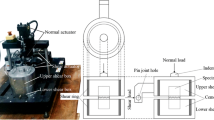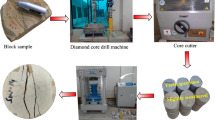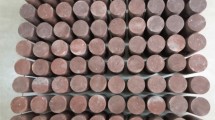Abstract
To investigate the effect of the loading rate on the tensile strength of rock material and the morphology of the resulting split fracture surfaces, three types of rock specimens, namely, granite, basalt and limestone, were collected and tested with Brazilian testing under different loading rates. The tensile strength was measured, and the effect of the loading rate on the tensile strength of the rock material was studied. Digital terrain map models of the split fracture surface were obtained with an optical 3D scanning technique, and the effects of the loading rate on the geometry and morphology of the fracture surface were studied. The influence of the loading rate and tensile strength on the roughness was studied quantitatively by calculating the roughness indices of a fracture surface for all three kinds of rock. The research results show that the rock tensile strength increases with the loading rate. A linear relationship was established in double-logarithmic coordinates to describe the relationship between the tensile strength and the loading rate. Four different roughness indices were used to describe the morphology of the split fracture surface. The analysis results show that the magnitudes of all the roughness indices increase with the loading rate. Additionally, the roughness indices for all three types of rock linearly increase with the tensile strength. This linear trend indicates that it is possible to utilize fracture surface roughness indices to estimate rock tensile strength. The current study may motivate further research on the relationship between the morphology indices of rock fractures and mechanical parameters of the rock.



















Similar content being viewed by others
Abbreviations
- \(A_{n}\) :
-
Nominal area of the fracture wall surface
- \(A_{t}\) :
-
Actual area of the fracture wall surface
- BHT:
-
Baihetan hydropower plant
- \(D\) :
-
Fractal dimension
- DTM:
-
Digital terrain map
- \(L_{x}\) and \(L_{y}\) :
-
Nominal lengths along the \(x\) and \(y\) axes
- \(N_{x}\) and \(N_{y}\) :
-
Total number of profile points in the \(x\) and \(y\) directions
- \(N\left( \delta \right)\) :
-
Total number of elementary surfaces s needed to cover the fracture surface
- RMS:
-
Root mean square
- \(R_{s}\) :
-
Fracture relative roughness coefficient
- R 2 :
-
Coefficient of determination
- SEM:
-
Scanning electron microscope
- TGP:
-
Three Gorges hydropower plant
- XLS:
-
Xianglushan water transmission tunnel
- \(z\) :
-
Height at a certain point
- \(Z2_{s}\) :
-
RMS of the surface first derivative
References
Backers T, Fardin N, Dresen G et al (2003) Effect of loading rate on mode I fracture toughness, roughness and micromechanics of sandstone. Int J Rock Mech Min Sci 40:425–433
Belem T, Homand-Etienne F, Souley M (2000) Quantitative parameters for rock joint surface roughness. Rock Mech Rock Eng 33:217–242
Derek H (1999) Fractography observing, measuring and interpreting fracture surface topography. Cambridge University Press, Cambridge
El-Soudani SM (1978) Profilometric analysis of fractures. Metallography 11:247–336
Gong FQ, Zhao GF (2014) Dynamic indirect tensile strength of sandstone under different loading rates. Rock Mech Rock Eng 47:2271–2278
ISRM (1978) Suggested methods for determining tensile strength of rock materials. Int J Rock Mech Min Sci Geomech Abstr 15(3):99–103
Khosravani MR, Silani M, Weinberg K (2018) Fracture studies of ultra-high performance concrete using dynamic Brazilian tests. Theor Appl Fract Mech 93:302–310
Lange DA, Jennings HM, Shah SP (1993) Relationship between fracture surface roughness and fracture behaviour of cement paste and mortar. J Am Ceram Soc 3:589–597
Li DY, Wong LNY (2013) The Brazilian disc test for rock mechanics applications: review and new insights. Rock Mech Rock Eng 46:269–287
Li XF, Li HB, Kai L et al (2017) Dynamic properties and fracture characteristics of rocks subject to impact loading. Chin J Rock Mech Eng 36:2393–2405 (in Chinese)
Li XF, Li X, Li HB et al (2018) Dynamic tensile behaviours of heterogeneous rocks: the grain scale fracturing characteristics on strength and fragmentation. Int J Impact Eng 118:98–118
Newman DA, Bennett DG (1990) The effect of specimen size and stress rate for the brazilian test - a statistical analysis. Rock Mech Rock Eng 23:123–134
Professional Standard Compilation Group of People’s Republic of China (2007) Specifications for rock tests in water conservancy and hydroelectric engineering (DLJ5368-2007). China Water Power Press, Beijing (in Chinese)
Sheikh MZ, Wang Z, Du B et al (2019) Static and dynamic Brazilian disk tests for mechanical characterization of annealed and chemically strengthened glass. Ceram Int 45(6):7931–7944
Takahashi K, Kido M, Arakawa K (1998) Fracture roughness evolution during mode I dynamic crack propagation in brittle materials. Int J Fract 90:119–131
Wang H, Ren C, Wan Y et al (2019) Experimental study on fracture process of sintered Nd-Fe-B magnets during dynamic Brazilian tests. J Magn Magn Mater 471:200–208
Zhang QB, Zhao J (2013) Effect of loading rate on fracture toughness and failure micromechanisms in marble. Eng Fract Mech 102:288–309
Zhang ZX, Kou SQ, Jiang LG et al (2000) Effects of loading rate on rock fracture: fracture characteristics and energy partitioning. Int J Rock Mech Min Sci 37:745–762
Zhao J, Li HB (2000) Experimental determination of dynamic tensile properties of a granite. Int J Rock Mech Min Sci 37:861–866
Zhou HW, Xie H (2003) Direct estimation of the fractal dimensions of a fracture surface of rock. Surf Rev Lett 10:751–762
Zhu WC, Niu LL, Li SH et al (2015) Dynamic Brazilian test of rock under intermediate strain rate: pendulum hammer-driven SHPB test and numerical simulation. Rock Mech Rock Eng 48:1867–1881
Acknowledgements
This work is supported by the National Key Research and Development Program of China (No. 2016YFC0401803), the National Natural Science Foundation of China (No. 41672319, No. 51779253, No. 52079133, and No. 51709258), Major project of the National Basic Research Program of China (No. 51991393), the Key Laboratory for Geo-Mechanics and Deep Underground Engineering, China University of Mining & Technology (No. SKLGDUEK1912), CRSRI Open Research Program (Program SN: CKWV2019746/KY), MOE Key Lab of Disaster Forecast and Control in Engineering, Jinan University (no. 20200904002), and the Youth Innovation Promotion Association, CAS.
Author information
Authors and Affiliations
Corresponding author
Ethics declarations
Conflict of interest
There is no conflict of interest in this work.
Additional information
Publisher's Note
Springer Nature remains neutral with regard to jurisdictional claims in published maps and institutional affiliations.
Rights and permissions
About this article
Cite this article
Cui, Z., Qian, S., Zhang, G. et al. An Experimental Investigation of the Influence of Loading Rate on Rock Tensile Strength and Split Fracture Surface Morphology. Rock Mech Rock Eng 54, 1969–1983 (2021). https://doi.org/10.1007/s00603-021-02368-4
Received:
Accepted:
Published:
Issue Date:
DOI: https://doi.org/10.1007/s00603-021-02368-4




